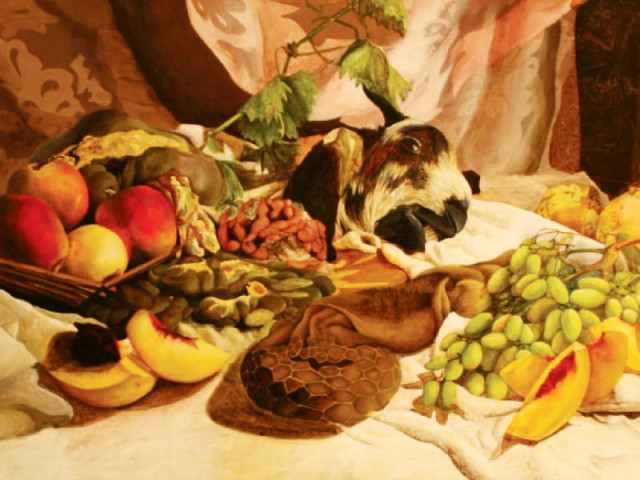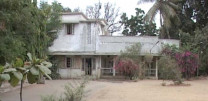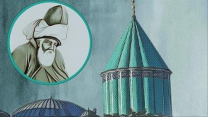NCA theses: Sold out - ‘reasonable’ pricing rules the day
Forty graduates look at dislocation, family ties, urban development and fertility.

Aroosha Khalil.
Saba Zahid was not expecting her honour’s result. However, she was one of the 14 honour students out of National College of Arts’ 2013 graduating class of 40. Speaking about her sold-out thesis work, Zahid said that keeping prices reasonable had been paramount to her.
“You have to induce people and galleries to buy your work as a graduate. This is a great opportunity for PR. I now have contacts who will hopefully buy my work in the future.”

Zahid’s subject matter was inspired by classic storybooks, specifically Edgar Alan Poe’s work. The paintings depict women performing everyday chores with expressions of surprise. “They are all caught doing something. I have also been inspired by film strips where there is action outside the image. I want the viewer to wonder about these startled expressions.” Zahid listed Francisco Goya and Gerhard Richter as stylistic influences for her ‘ominous, dark’ work. Her larger works is priced at Rs60,000 while the smaller one are Rs25,000.
As many as eight students were awarded distinctions this year and 14 graduated with honour.
Selling all her work before the thesis display began gave Kirin Chaudhary a strong sign that she should continue painting. “Art collectors and curators arrive before the display starts to get the best pieces. People have shown a strong interest in my work.” Chaudhary’s inspiration was the Madonna and Child. “I was raised by a Christian nanny. This work represents my relationship with a minority group. The baby is my nanny’s daughter.” Chaudhary worked with charcoal on paper, as the medium ‘has a lot of expression and energy.’ Her work is priced between Rs60,000 and Rs20,000.

Mina Arham’s work paid homage to Lahore. She used blanco tape, graphite on paper and lino-cuts to produce images of the city. Arham took photos of the city and buildings. “I wanted to show interpretations of the city with no economic, political or social aspect to it. I wanted to engulf the space. I see the city as an infinite idea.” “I started with one image of Lahore and realised that it was not enough,” Arham pointed to a piece comprising five different sections (a total of four feet by 10 feet). “I took a print out and then carved it some more, continuing on the same plate. It was an idea of the city changing and growing. Some aspects remain but you cannot return to the original. Much like I can’t print out from the original plate anymore,” she continued. Arham said she planned to continue exploring other mediums. Her work was priced between Rs30,000 and Rs50,000.

Ramish Rana
Amna Kazmi worked in mixed media to create images that “explored the process of the visual in the process of making art”. She said her work was inspired by her journey of different stages of making art, perceptions and being guided through this process. “We are told that art is relative yet we are also judged. My work is a monologue.” She said one of her pieces depicted her burning her own work and building new work from the ashes. Kazmi’s work is priced between Rs25,000 to Rs50,000.

Zoya Manan literally made her misery into art. “I had surgeries for cerebral palsy and was on bed rest for four months. Physically I was confined to my bed but mentally I was active. This state was important. I needed my frustrations to come out.” Manan said her work dealt with the absence of presence, of being physically present but mentally absent. “I used contradictory colours so that the viewer could experience imbalance as cerebral palsy is all about balance.”
Manan’s subjects were her helpers who took care of her. “I did not want to portray myself directly. I wanted my work to go beyond me.”

Manan said that it was important to her that her work progress. “It started with rigidity, moved on to my environment, claustrophobia and then the body. I think I might explore the body further in my future work.” She said that she would be working on some commissions after she takes a month off from work.
Anam Zaman took photos of interior and exterior spaces and blended them together in ‘an odd contrast.’ Her work is priced between Rs25,000 and Rs35,000.

Sidra Asim stressed that her subject matter was not her mother even though she appeared in many of Asim’s canvases. “I used the character of my mother as a caricature. I then looked at objects associated with people. For instance, a pillow might not be important but it is present and represents a human.” Asim worked on different papers and then proceeded to work on silk. Many of her pieces combine paper and cloth. “The material became part of the character study.” She added that there were hidden questions in her work. “The woman is looking at something and is pointing at someone in different pieces and that brings up the question of history and context.” Asim’s work is priced between Rs25,000 and Rs30,000 and was sold out.
Dislocation, relocation and questions of family ties colour Anam Bhatti’s installation. An arm chair piled with clothing and odds and ends is surrounded by photographs and a small monitor showing video clips from her childhood. “My father was exiled during General Ziaul Haq’s rule. We returned in 1993 after my fourth birthday. I was then told that my home prior to my return was not really my home. I now had a new family which was to be my ‘real’ family.” Bhatti mixed images of blood relatives with those she considered family while living in exile. The video shows her playing with children who are not related to her. “The arm chair depicts the idea of travel and how comfort was no longer supreme.”
“I was expecting a better result,” said honours recipient Ahmed Saeed. Saeed traces his lineage from a long line of miniature artists (“There are 14 generations of my family in miniature”). His great grandfather had been a court painter in India, Saeed added. “My work crumples the media-created myth of the Mughal ruler. The Mughal Empire was ruled by the court - not one man. The court would decide matters as trivial as whether the emperor was to go to his harem or not. Other than busting popular myth regarding the Mughals, Saeed said, his work also looked at the current situation in the country. “We aspire to a European lifestyle but we are Asian. We are a remixed culture.” His work, which was sold out, is priced at Rs30,000 to Rs50,000.
Miniaturist Hina Muhammad examined her life journey to produce work. “I look at how an individual is affected as she moves from a somewhat constrained society to one where she has more freedom.” Muhammad who comes from Peshawar intends to stay on in Lahore and continue working on her art. Her work is priced between Rs25,000 and Rs30,000.
Faryal Ahsan’s miniatures, Parody of the Puppets, took original Mughal miniatures from the Babur-Nama and Jehangir-Nama as their inspiration. “In those pieces, each work was laboured over by 15 to 20 artists who each had his own niche. I used that idea and made my pieces look like they were cut and paste jobs. Of course, all of them are painted but that is the impression they give.” Ahsan, who was awarded a distinction, priced her work between Rs30,000 and Rs40,000.
Aroosha Khalil’s work was inspired by Dutch Renaissance painters. “I wanted to show the complete process of decomposition but I wanted it to be painted beautifully and that it should be inviting. The process of decomposition is usually smelly and dirty and no one wants to look at it.” She said she had placed edible and non-edible items together to get an odd contrast. “I documented this whole process and there was a gross feel to it but when I was painting it I wanted to diminish that feeling.” Her work is priced at Rs40,000 a piece.
Mustard seeds and beads are used in Ramish Rana’s work that examines the relationship between children and women who cannot conceive. “I would like to consider myself a feminist and pick up issues that pertain to women, especially women in the domestic sphere. I used organic materials to show a link to women.” Rana said she used colours that depict fertility in different cultures. “But I have used these in an ironic manner to depict infertility.” Rana priced her work at Rs25,000 to Rs40,000.
Burning matchsticks on paper, Muzamal Khan took a swipe at urban development. “My work is beautiful from afar but as you go closer you realise that I have burnt matchsticks. If I had ignored the burning, the work would have been destroyed. In the same way, development has brought some positive change but we cannot ignore all the negative connotations.” Khan’s pieces, which also employ miniature techniques, are priced at Rs60,000.
Pricing it right
“My work should be like gold for collectors. Over time the value should increase,” Faryal Ahsan was explaining the reason behind her ‘low’ pricing. She was also repeating a refrain that clearly held currency with several students. ‘Reasonable’ pricing was the cry of the day. Many students had had been ‘advised’ to keep their prices low.
NCA Head of the Fine Arts Department Prof Bashir Ahmed, however, clarified that pricing was under the complete control of the students. “Yes, we make suggestions and recommendations but nothing more. There is no compulsion regarding setting of prices.”
The exhibition will continue till January 26.
Published in The Express Tribune, January 18th, 2014.



















COMMENTS
Comments are moderated and generally will be posted if they are on-topic and not abusive.
For more information, please see our Comments FAQ